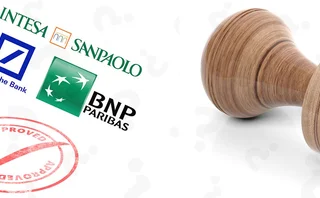
Unwelcome breakdown
After coming close to defaulting on a punishing repayment schedule, Welcome Break eventually repaid its whole-business securitisation at par last month. But bondholders were denied the chance to seize the company’s assets, as Oliver Holtaway reports

Key points |
• Exogenous shocks to the business and a flawed repayment schedule led to Welcome Break’s near default. |
In 1997, UK motorway service operator Welcome Break’s £321 million bond issue was the first UK whole-business securitisation to hit the sterling market. Last month, it was repaid at par after more than a year of painstaking negotiation between Investcorp, its owner, and its creditors – having yielded just one coupon payment. While this outcome is in fact more positive than some investors had feared, questions are now being asked as to why the deal failed – and why the failure of a whole-business securitisation bond has not resulted in the creditors taking over the whole business.
Welcome Break’s bond market troubles kicked off in May 2002, when RBS analyst Steven Behr warned investors that the firm would probably not be able to meet its punishing debt repayment schedule, and was likely to breach its debt service cover ratio in late 2004. Behr’s analysis caused panic among bondholders – senior paper fell from near par to 55 points, while junior paper sunk as low as 15 points.
Behr now claims that the poor design of the repayment schedule was the fatal flaw. “Welcome Break had a seven-year payment holiday, and then fell at the first hurdle. The whole £376 million debt [the deal was tapped by £55 million in 1998] was compressed into a 13-year period – they had to fork out around £20 million a year for the first few years, with even larger payments after that.”
According to a Fitch note published in November 2003, Welcome Break’s quarterly debt service would have been £8.7 million beginning June 2004, increasing to £12.1 million per quarter after September 2004.
Investcorp had felt comfortable taking on this debt repayment schedule because it had overestimated the potential for revenue growth.
Traffic trends cited in the bond offering showed a 127.6% increase in motorway traffic between 1981 and 1994, with traffic levels rising 5.6% per annum during economic expansion and 1% during recession. It also noted a trend towards increased car ownership, and the anticipated loosening of the regulatory environment around the motorway services industry – for example allowing service stations to be built within 15km of each other, rather than 30km.
Double impact
But the motorway service area industry has suffered two major exogenous shocks since 1997. First came the petrol crisis of 2000, which severely disrupted revenues in the short term. Second, the decline in tourism to the UK following the terrorist attacks of September 2001 had a negative knock-on effect on traffic volumes on UK motorways. Although the impact of these is hard to quantify, it was nevertheless clear by early 2002 that Welcome Break, despite high capital expenditure in improving the service stations, was not reaching the levels of revenue anticipated by the bond offering. Default looked likely.
By 2003, Investcorp recognised the problem. On June 5 last year, Investcorp approached bondholders with a buyback offer. It would be the start of a 12-month saga.
The Welcome Break bond issue was split into three Class A tranches, which ranked pari passu with each other, and a subordinated Class B tranche. The former totalled £309 million, the latter £67 million.
According to public statements of holdings compiled by data provider Lipper eMaxx, the A-notes were mostly held by institutional investors such as M&G, Invesco, Insight Investments, Royal London Asset Management and Henderson Global Investors, at least as late as 2003.
The B-note holders had initially been real-money investors, but many became forced sellers after Fitch downgraded the notes to junk in February 2002. Distressed hedge funds then picked the bonds up, although Morley Fund Management was one real-money firm still holding Welcome Break paper to the end. Odey Asset Management and Sisu Capital were the hedge funds with the largest stakes in the B-tranche – Sisu reportedly held around 30% of the B-notes.
An offer they could refuse
The first four buyback offers were made between June 5 and July 23, 2003. Investcorp intended to fund a buyback through the sale and leaseback of two service stations. But from the very start of negotiations, the bondholders’ chief complaint was that Investcorp was acting against the spirit of the bond deal.
These first four offers all involved partially repaying both classes of bondholder, with some variations. The buyback offers were based on the £230.2 million anticipated proceeds from the sale and leaseback programme. Investors were unsatisfied for two reasons.
First, the A-note holders were furious that B-note holders should receive anything before the A-notes had been fully repaid. This, they argued, went against the basic principle of subordination; Investcorp was treating B-note holders with undue generosity in an effort to rid itself of the B-notes, which carried a more expensive 8.284% coupon.
To repay at anything less than par, Investcorp needed the consent of at least 75% of both bondholder classes. As reported in the July/August 2003 issue of Credit, some investors felt that Investcorp was attempting to turn different classes of bondholder against each other; it was hoped that this divide-and-conquer approach would intimidate investors into agreeing to the refinancing proposals on offer at the time. If this was the strategy, it worked for at least one bondholder – a major A-note holder sold its stake to RBS, says Behr, “in order to avoid the headache”.
The second reason was Investcorp’s presumption that investors would consider a partial repayment reasonable. As Behr said at the time, it seemed as though Investcorp preferred to convince investors that Welcome Break’s position was weak, “so that investors will count themselves lucky to accept what is on the table”.
Both classes of bondholder rejected the offers on August 13, 2003.
After arranging the sale of service stations to Roadster – a joint venture between RBS and property giant Rotch – Investcorp returned with more generous offers to bondholders. This time, A-note holders were offered par, and B-note holders offered 45% – later raised to 55%. A-note holders accepted, but B-note holders rejected the offer.
Unable to reach a deal, Investcorp put Welcome Break Finance, the issuing body, into administration. This constituted an event of default, leaving bondholders to take Welcome Break Finance into administrative receivership.
Bankers Trust, the bonds’ trustee, appointed Neville Kahn of Deloitte & Touche as administrative receiver – but only after insisting that A-note holders indemnify the trustee against possible litigation from the B-note holders. Under the terms of the B-notes, holders lost their voting rights as a consequence of the receivership. Eight A-note holders agreed to assume the litigation risk.
Bluffed into folding
But soon after the receivers were appointed, Investcorp unexpectedly offered full repayment to both classes at par; both accepted. “We were surprised at how quickly Investcorp capitulated,” says one investor.
James Roome of law firm Bingham McCutchen, which represented B-note holder Sisu Capital, credits much of the success to the professionalism of the receivers. “Neville Kahn made it clear that the bondholders would not sell the inter-company loan at discount, but would take time to get the right price – they were prepared to sit it out until the inter-company loan defaulted, so they could gain access to Welcome Break Group’s assets. Investcorp’s bluff was called,” says Roome.
Bondholders expressed relief that the matter had finally been brought to a close. But Investcorp’s decision to allow the issuer Welcome Break to fall into administration, while signing off the borrower Welcome Break Group as a going concern, raised investor eyebrows.
Investcorp had previously threatened to put Welcome Break Finance into administration before the initial interest repayment fell due on March 1, but backed down after bondholders resisted the move.
The challenge for Investcorp was how to put the issuer Welcome Break Finance into administration without losing grip of the borrower Welcome Break Group’s assets. To this end, Investcorp offered a non-binding letter of support to Welcome Break, pledging to fund the firm’s debt obligations – but on the condition that Welcome Break Finance was put into administration. On this basis, the directors of Welcome Break Finance were able to convince auditor PricewaterhouseCoopers to affirm that the value of the inter-company loan made by Welcome Break Finance to Welcome Break Group had been impaired. Once this occurred, it became easier for Investcorp to put Welcome Break Finance into administration.
But while the impairment to Welcome Break Finance’s primary asset was recognised, there was no parallel recognition of the problem in Welcome Break Group’s accounts. Investcorp was able to default its whole-business securitisation deal without bringing its business under serious threat.
In fairness to Investcorp, a default at the borrower level would have been disastrous, bringing with it the threat of bank loans being called in and suppliers removing petrol from its forecourts.
But the idea of a whole-business securitisation is that, in the event of default on the securities, investors assume control of the whole business. Investcorp was able to manipulate weaknesses in the structure of the Welcome Break Finance bond to ensure that Welcome Break Group’s assets would stay out of bondholders’ hands.
Bingham’s Roome says that note-holders believed that, under a whole-business securitisation structure, they would have recourse to Welcome Break’s underlying assets in the event of an issuer default. “The underlying assumption of the structures is, as long as the borrower can pay its debt, there is no danger of insolvency to the issuer,” he says. “But Investcorp put Welcome Break Finance into administration even though the inter-company loan was current. They knew that administration would automatically strip B-note holders of their voting rights.”
And bondholders wanted to get their hands on Welcome Break’s assets. Of course, most bond investors would prefer to spend their time investing in bonds, rather than taking on the assets or businesses that have defaulted on their debts. But within the ABS/WBS universe, some assets are more attractive than others. Eurotunnel creditors will be keen to avoid ending up owning a hole in the ground; holders of a champagne house’s bonds would not feel as bad about getting their hands on the assets that back their securities. Welcome Break falls more into the champagne end of the spectrum: it is a stable, cash-generative firm with solid business fundamentals.
Sisu Capital’s chief executive Joy Seppala says: “We have all along believed that Welcome Break is a valuable business and we are disappointed that there will not now be an opportunity for the assets.”
A happy ending?
Before one starts to feel too sympathetic towards Welcome Break’s bondholders, it’s worth noting that several investors profited from the bond’s recovery to par. In particular, hedge funds that bought the B-notes after they hit distressed levels have cleaned up. In fact, many institutional investors were frustrated at being forced to sell their B-notes early.
But investors will also be counting the opportunity cost. The bonds have not paid any coupons, after all. A3 investors will miss out on 12 years’ worth of interest payments. Now, they are forced to reinvest the par amount in the middle of a much lower interest rate environment.
“The coupon for the A3 tranche was 7.95%; investors would struggle to find similar returns in a WBS senior tranche today,” says RBS’s Behr. A 2003 Punch Taverns WBS bond, which was rated A- by Standard & Poor’s, carried a 5.88% coupon, for example. For every 100bp knocked off the coupon, investors in WBF’s £127 million A3 tranche would lose a total of £1.27 million a year – over 20 years.
The whole-business securitisation market has matured since the launch of the Welcome Break deal, says Michael Cox, structured finance analyst at Fitch Ratings.
“Many of the lessons have already been learnt: since 2001, whole-business securitisation deals have been less heavily leveraged, and amortisation schedules start from day one,” he says.
But while Cox claims that bondholders now understand the structures better, investors are still advised to check the fine print in order to ensure that, if things go wrong, they really do have a claim on the assets they think they do.
Countdown to repayment August 1997 October 1998 June 5, 2003 Offer #1 June 27 Offer #2 July 9 Offer #3 July 23 Offer #4 August 13 January 28, 2004 Offer #5 Febuary 11 Offer #6 Febuary 26 March 1 May 21 May 25 May 27 Offer #7 |
Only users who have a paid subscription or are part of a corporate subscription are able to print or copy content.
To access these options, along with all other subscription benefits, please contact info@risk.net or view our subscription options here: http://subscriptions.risk.net/subscribe
You are currently unable to print this content. Please contact info@risk.net to find out more.
You are currently unable to copy this content. Please contact info@risk.net to find out more.
Copyright Infopro Digital Limited. All rights reserved.
You may share this content using our article tools. Printing this content is for the sole use of the Authorised User (named subscriber), as outlined in our terms and conditions - https://www.infopro-insight.com/terms-conditions/insight-subscriptions/
If you would like to purchase additional rights please email info@risk.net
Copyright Infopro Digital Limited. All rights reserved.
You may share this content using our article tools. Copying this content is for the sole use of the Authorised User (named subscriber), as outlined in our terms and conditions - https://www.infopro-insight.com/terms-conditions/insight-subscriptions/
If you would like to purchase additional rights please email info@risk.net
More on Regulation
Risk, portfolio margin, regulation: regtech to the rescue
A white paper outlining the complexity of setting the course for risk, margin and regulation
Prop shops recoil from EU’s ‘ill-fitting’ capital regime
Large proprietary trading firms complain they are subject to hand-me-down rules originally designed for banks
Revealed: the three EU banks applying for IMA approval
BNP Paribas, Deutsche Bank and Intesa Sanpaolo ask ECB to use internal models for FRTB
FCA presses UK non-banks to put their affairs in order
Greater scrutiny of wind-down plans by regulator could alter capital and liquidity requirements
Industry calls for major rethink of Basel III rules
Isda AGM: Divergence on implementation suggests rules could be flawed, bankers say
Saudi Arabia poised to become clean netting jurisdiction
Isda AGM: Netting regulation awaiting final approvals from regulators
Japanese megabanks shun internal models as FRTB bites
Isda AGM: All in-scope banks opt for standardised approach to market risk; Nomura eyes IMA in 2025
CFTC chair backs easing of G-Sib surcharge in Basel endgame
Isda AGM: Fed’s proposed surcharge changes could hike client clearing cost by 80%
Most read
- Podcast: Olivier Daviaud on P&L attribution for options
- For a growing number of banks, synthetics are the real deal
- SG trader dismissals shine spotlight on intraday limit controls







